What changes during cooking?
What changes is not the amount of calories, but how the way they are divided in relation to the volume or the cooked food weight. There are foods such as chicken or meat breasts that lose fluid and shrink while cooking. In practice, this means that the remaining calories remain in a smaller weight of food. For example, 100 grams of living chicken will become about 80 grams of cooked chicken, but the calories will remain the same. In contrast, foods such as rice, pasta and legumes absorb fluid and inflatable during cooking. This means that the calories are included in a larger amount of food. For example, 100 grams of dry rice turn into 230 grams of cooked, and they still contain 365 calories in total.
Why is that anyway?
So the cooking doesn’t change the total calories, but since the dish volume is changing, it may be less satisfying. Therefore, if we eat exactly the same food after cooking, we will probably not be seventy as we could have had to eat it before cooking.
To sum up: Cooking does not change the number of calories, but only their division in relation to weight and volume. Foods that lose water become more concentrated in calories, while foods that absorb water grow in volume and sprinkle the calories. Understanding these changes are important in accurate nutritional planning and quantity management. Remember: calories remain, but the weight and volume – varying what may affect our level of satiety.
